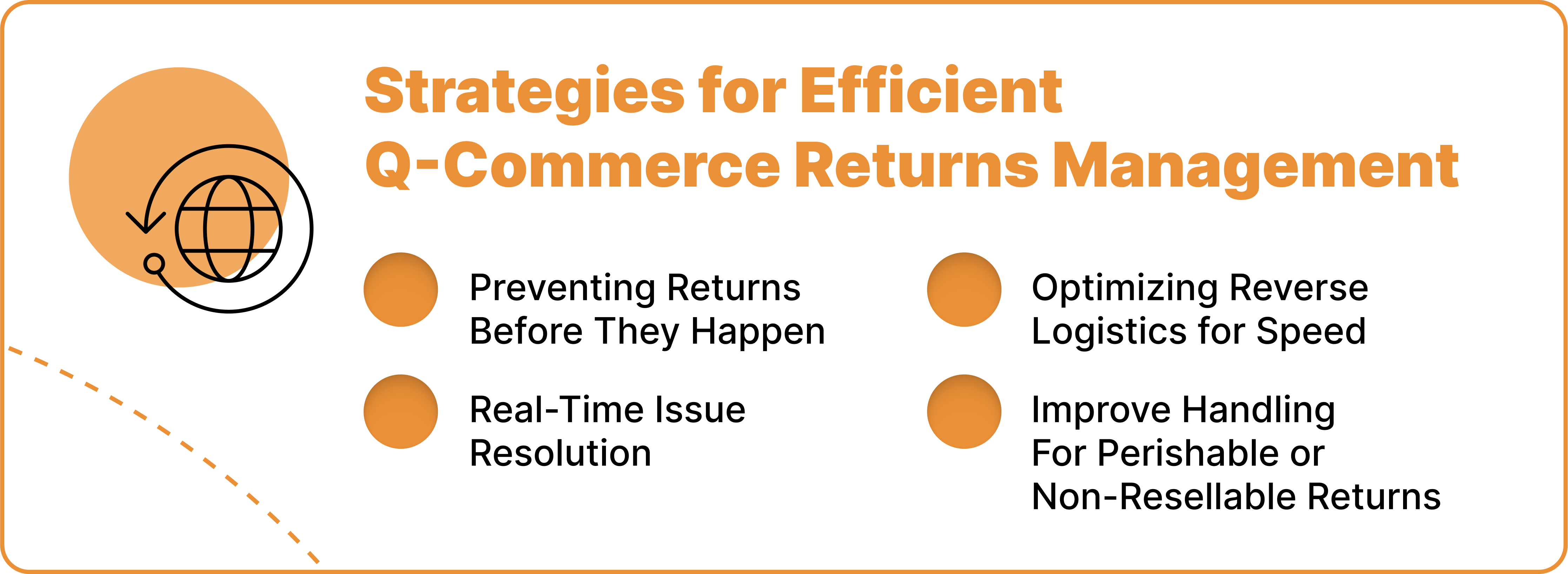Q-Commerce Returns: Managing Returns in the Age of Quick Commerce

The demand and option of faster deliveries have transformed logistics for retailers and customers’ shopping experiences. Today, quick-commerce (or Q-commerce in short) pushes online retailers to provide instant delivery options, leading to an exponential increase in customers demanding and expecting products such as groceries and essentials at their door within minutes. But what happens when something needs to be returned? Q-commerce returns can be messy without a solid plan.
Just like with their deliveries, customers don’t want long waits for their returns, and Q-commerce retailers cannot afford delays. However, unlike traditional e-commerce returns, hyperlocal logistics operations make handling returns tricky. The Q-commerce business model necessitates small fulfillment centers that operate on tight stock levels, and quick turnarounds leave little room for errors. Without express return solutions, costs rise, waste increases, and customers lose trust.
The key is speed. A good returns system should be as fast as the delivery itself. Businesses need a process that prevents unnecessary returns, resolves problems in real time, and keeps products moving. This article breaks down practical steps to make Q-commerce returns seamless, cost-effective, and customer-friendly.
Understanding the Complexity of Q-Commerce Returns
The idea behind quick commerce is that goods are delivered quickly, most often within minutes. However, with such speed comes increased exposure to mistakes, whether sending the wrong products or mishandling the products in transit, which ultimately triggers Q-commerce returns.
Some of the more common reasons for returns include:
1. Wrong items
This is usually the case when there is rushed packing, which in turn leads to mix-ups. For example, a customer orders low-fat or skimmed milk but gets unskimmed milk.
2. Damaged goods
Speedy handling increases the likelihood of carelessness in the shipping process. Whether it is during transit or while handling. The result is usually breakage, especially for fragile products like eggs or glass bottles.
3. Quality complaints
Sometimes, products may stay in inventory longer than it is supposed or intended to. The problem with this is that it impacts the quality of the product, and customers often tend to notice. A typical example is fresh food arriving wilted or past its best condition.
4. Order cancellations
Sometimes, when orders are delayed, customers may change their minds. Other times, it is the customers changing their minds because of personal reasons. Whatever the case, if the item is already out for delivery, returning it becomes tricky.
Key Challenges of Managing Q-Commerce Returns
The problem with Q-commerce returns is that, unlike traditional e-commerce, where customers can return products days later, Q-commerce retailers need a return system that works instantly.
Here is why:
1. Time Sensitivity
Customers expect fast refunds or replacements. If a delivery takes 10 minutes, waiting several days for a return feels slow. Businesses must act quickly.
2. Product Viability
Many returned items cannot be resold. A returned ice cream tub has already been out of refrigeration longer than it should, and opened personal care products cannot be returned to the shelves. Businesses must decide whether to refund, replace, or discard items.
3. High Return Costs
Handling returns costs money. Restocking takes time. Sending a delivery agent to collect a returned product adds delivery expenses. Without proper management, return costs eat into profits.
4. Logistics Bottlenecks
Q-commerce works on hyperlocal logistics, meaning fulfillment centers store limited stock. If items are returned frequently, it disrupts stock levels and delivery resources and leads to waste.
Strategies for Efficient Q-Commerce Returns Management

Despite the challenges associated with Q-commerce returns management, it is not impossible to pull off, especially when you have the right strategies. Here are some of the ways to optimize Q-commerce returns:
1. Preventing Returns Before They Happen
The best returns are those that never happen. Whatever the case, your best strategy is to reduce the return volume as much as possible. It is possible to do this if you have the right approach. For instance, leveraging tech solutions, especially in this AI age, will reduce human errors, which means fewer returns.
Using clear product descriptions ensures that the customer has an accurate expectation. Now, that may sometimes mean fewer sales, but it beats having to process returns and lose money on that end. Another way to prevent returns is by improving the packaging. For example, more care should be paid to fragile items because they need extra protection to prevent damage in transit.
2. Real-Time Issue Resolution
As we mentioned earlier, just as your business can ensure instant deliveries, customers expect the same service when it comes to returns. They do not want to wait days for a return to be processed. Businesses can solve issues instantly by implementing live customer support, such as quick chats or calls, to resolve problems before the return option is activated.
Another way to resolve issues quickly is to set up instant refunds for low-cost items. If a product costs less than the cost of a return, refunding immediately makes more sense. On the other hand, it also works if your business can offer partial refunds if the product is fine but the packaging is damaged. That way, your customers are happy. However, there is a risk of abuse with this immediate refund model.
3. Optimizing Reverse Logistics for Speed
The success of the Q-commerce business model. Your returns must be just as fast, or else your customers will think you are not being fair. It might sound like a small matter, but it ultimately impacts sales on the front end. To avoid that, train delivery riders to handle returns as efficiently as possible. If a customer refuses an order at the door, the rider can take it back immediately.
You can also set up return drop-off points. Instead of sending a rider for pickup, customers can return items at nearby micro-fulfillment centers. That way, you and the customer can meet in the middle. However, to make this work, you must collaborate with delivery partners or third-party reverse logistics providers and returns management solutions to ensure quicker processing.
4. Improve Handling For Perishable or Non-Resellable Returns
Because of the nature of the Q-commerce business model, many items cannot be resold. This means there is a need for smarter options when dealing with waste. For instance, refunding the customer without going through the returns process is one possibility. Food items can also be sent to local food banks instead of being thrown away. If for nothing else, think of it as a goodwill or marketing campaign. Products like expired food or opened personal care items must be disposed of properly to meet safety standards.
Measuring Success: Key Metrics for Returns in Q-Commerce
Tracking the right data helps your Q-commerce business refine its return processes. The following will help
- Return rate by product type – If a specific item is returned often, there might be a quality issue.
- Refund processing time – Faster refunds improve customer satisfaction.
- Customer complaints related to returns – Many complaints signal problems in the return system.
- Operational costs of returns – Keeping return costs low ensures profitability.
Enhance Your Q-Commerce Returns With ReverseLogix
Q-commerce returns are a challenge, but retailers that plan well can turn returns into a smooth part of their operations. One way to do that is by leveraging the returns management solutions that deliver on prompt processing, better customer returns process, and efficiency across the board. That solution is ReverseLogix. By focusing on prevention, quick issue resolution, and smart logistics, ReverseLogix can ensure significant cost savings and improved customer satisfaction.
The assurance of fast and efficient delivery made Q-commerce popular. Handling returns with the same efficiency will keep customers coming back. Connect with us today to see the difference.

Frequently Asked Questions
Q-commerce returns happen fast because deliveries are instant. Traditional e-commerce allows customers to return items days later. In Q-commerce, items are often returned immediately, sometimes at the doorstep, which changes how businesses handle them.
Many returns result from mistakes in picking and packing. Customers may receive the wrong item, something damaged during delivery, or a product that does not meet their expectations. Food and personal care products also have strict quality concerns.
Q-commerce relies on hyperlocal delivery service, meaning small storage hubs keep only limited stock. A high number of returns affects inventory and can create waste, especially with perishable goods. The need for fast restocking and replacements makes managing returns more complicated.
Using automated picking systems, better packaging, and clear product descriptions can help with meeting customer expectations and reducing the necessity for returns. Businesses can also allow customers to confirm orders before dispatch to streamline the supply chain and catch mistakes early.
Hyperlocal logistics refers to delivering goods and services within a very small, localized area, like a neighborhood or city. It offers faster, more personalized, and cost-effective delivery options. The primary idea is to ensure convenient delivery.
